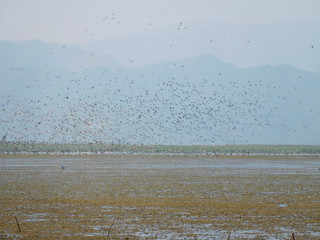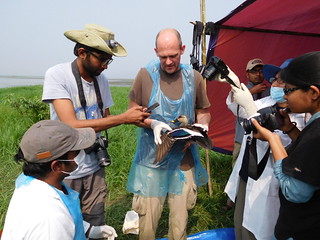Richard Hearn
Wildfowl & Wetlands Trust

 Top: Waterbirds at Tanguar Haor Bottom: Ringing Spot-billed Duck at Tanguar Haor © Ruth Cromie (WWT)
Top: Waterbirds at Tanguar Haor Bottom: Ringing Spot-billed Duck at Tanguar Haor © Ruth Cromie (WWT)
We have just returned from working with IUCN Bangladesh and the Bangladesh bird club (Bbc) to develop a programme of duck capture and ringing, and wild bird surveillance for avian influenza, at Tanguar Haor [EAAF105], a vast Ramsar site in northern Bangladesh. The site is of huge global importance for wintering waterbirds and the number of birds present during our visit was staggering – just prior to arriving the BBC had completed the International Waterbird Census count and found approximately 100,000 waterbirds. The most numerous species were Red-crested Pochard, Gadwall, Garganey, Ferruginous Duck and Coot, with good numbers of Pintail, Shoveler, Little Cormorant, Indian Pond-heron, Great White Egret, Intermediate Egret, Purple Swamphen and Black-tailed Godwit.
In order to support IUCN Bangladesh in developing a wild bird surveillance programme for avian influenza, as part of a project funded by the U.S. Department of Agriculture, we helped demonstrate how to make and use traps and mist nets to capture ducks, and how to carry out the ringing and disease sampling. We set up traps and mist nets and caught a number of ducks (Indian Spotbill, Red-crested Pochard, Eurasian Wigeon, Common Pochard and Ferruginous Duck), Coot and Little Grebe. Although the total number of birds caught was only c.40, these were the first ducks to be ringed in Bangladesh and the trip provided an excellent opportunity to train IUCN and Bbc staff and volunteers in the basics of waterbird capture and to get to know the site and how best to use the capture methods available to us. With the knowledge we gained we hope to return next winter to further expand the trapping programme.
Further information about the project can be found on IUCN’s website.




